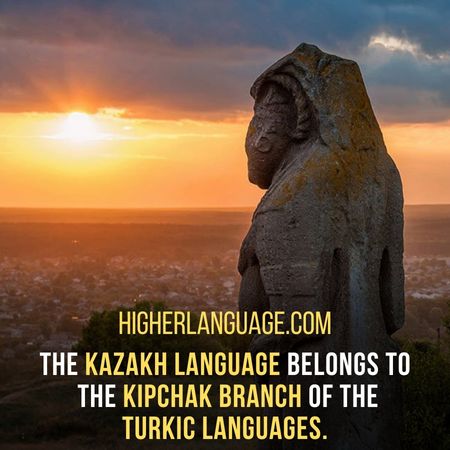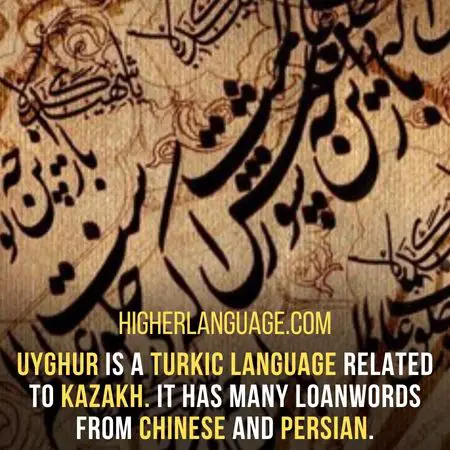The Kazakh language gets spoken in Central Asia. Hence there are languages similar to Kazakh that are mostly spoken around the region.
Let us look at those languages in detail and how they are similar to or different from Kazakh.
Languages Similar To Kazakh
Kazakh is the official language of Kazakhstan. Ethnic Kazakhs also use it in neighboring countries such as Uzbekistan, Turkmenistan, and Russia.
The language has the influence of Russian and Arabic due to the region’s history.
It also has the influence of Turkic languages such as Azerbaijani, Turkish, and Tatar.

Kazakh belongs to the Kipchak branch of the Turkic languages. That branch includes Kyrgyz, Karakalpak, and Crimean Tatar.
These Languages are all descendants of the Common Turkic Language.
The nomadic tribes of Central Asia mostly spoke Kazakh. That happened before the arrival of Russian settlers in the region.
The languages similar to Kazakh share linguistic roots. It is also because they have influenced Kazakh or vice versa.
The top 9 languages similar to Kazakh are as follows:
1. Uzbek:
Uzbek is the official language of Uzbekistan and gets spoken by around 33.6 million people.
It is also spoken in Tajikistan, Kyrgyzstan, Turkmenistan, and other countries.
It is a Turkic language that is similar to Kazakh. Uzbek has many loanwords from Russian, Persian, and Arabic.
Uzbek and Kazakh have several similarities. They are both Turkic languages. Hence both languages share a common ancestry.
They also use the same alphabet and have similar grammar rules.
However, there are some differences between the two languages. For example, Uzbek has more Persian loanwords than Kazakh.
They both use the Cyrillic alphabet. This makes both languages quite similar to each other.
2. Turkmen:
Turkmen is the official language of Turkmenistan. It gets spoken by around 7 million people. It is also spoken in Iran, Afghanistan, and other countries.
It is a Turkic language related to Kazakh. Like Uzbek, Turkmen also has many loanwords from Russian and Persian.
Turkmen and Kazakh have several similarities. They are both Turkic languages, which means they share a common ancestry.
They also use the same alphabet and have similar grammar rules.
However, there are some differences between the two languages. For example, Turkmen has more Persian loanwords than Kazakh.
Turkmen and Kazakh share a common Turkic ancestry. They both use the Latin alphabet and have similar grammar rules.
However, there are some differences between the two languages. For example, Turkmen has more Persian loanwords than Kazakh.
3. Kirghiz:
Kirghiz is the official language of Kyrgyzstan. Around 4.5 million people speak Kirghiz.
It is a Turkic language related to Kazakh, with many loanwords from Russian and Persian.
Other countries that have Kirghiz speakers include Kazakhstan, Uzbekistan, and China.
Kirghiz and Kazakh have several similarities. They are both Turkic languages, which means they share a common ancestry.
However, there are some differences between the two languages. For example, Kirghiz has more Russian loanwords than Kazakh.
Kirghiz and Kazakh share a common Turkic ancestry. They both use the Cyrillic alphabet and have similar grammar rules.
Their common ancestry makes Kirghiz and Kazakh similar to each other.
4. Tatar:
Tatar is the official language of Tatarstan, and about 5.1 million people speak it. It is also a Turkic language related to Kazakh.
Tatar and Kazakh have several similarities. They are both Turkic languages, which means they share a common ancestry.
They also use the same alphabet and have similar grammar rules.
However, there are some differences between the two languages. For example, Tatar has more Russian loanwords than Kazakh.
Tatar is also spoken in other parts of Russia, as well as in Kazakhstan, Ukraine, and Belarus.
Tatar and Kazakh share a common Turkic ancestry. They both use the Cyrillic alphabet and have similar grammar rules.
Similar alphabets make it easy for language speakers to learn from each other.
5. Uyghur:
Uyghur is the official language of Xinjiang province in China. Around 11 million people speak Uyghur worldwide.

It is also a Turkic language related to Kazakh, with many loanwords from Chinese and Persian.
Uyghur and Kazakh have several similarities. They are both Turkic languages, which means they share a common ancestry.
They also use the same alphabet and have similar grammar rules.
There are some differences between the two languages. For example, Uyghur has more Chinese loanwords than Kazakh.
This difference makes the two languages unique and different. Yet their common ancestry makes them similar to each other
6. Kyrgyz:
Kyrgyz is the official language of Kyrgyzstan and gets spoken by around 4.5 million people. It has many loanwords from Russian and Mongolian languages..
Kyrgyz and Kazakh have several similarities. They are both Turkic languages, which means they share a common ancestry.
They also use the same alphabet and have similar grammar rules.
However, there are some differences between the two languages. For example, Kyrgyz has more Russian loanwords than Kazakh.
Even so, Kazakh speakers can learn Kyrgyz faster than any other language.
7. Turkish:
Turkish is the official language of Turkey, spoken by around 77 million people. It is also spoken in Cyprus, Greece, Bulgaria, and other countries.
Kazakh is closely related to Turkish, sharing a common ancestry. Both languages use the Latin alphabet and have similar grammar rules.
However, there are some differences between the two languages. For example, Turkish has more French loanwords than Kazakh.

Turkish is also related to Kazakh, as both languages belong to the Turkic family of languages.
However, Turkish is more closely related to Azerbaijani and Uzbek than Kazakh.
Hence there are some differences between Turkish and Kazakh vocabulary and grammar.
Nevertheless, speakers of both languages can generally understand each other without difficulty.
8. Azerbaijani:
Azerbaijani is the official language of Azerbaijan, spoken by around 9 million people. It is also spoken in Iran, Georgia, Russia, and other countries.
Azerbaijani and Kazakh share a common Turkic ancestry. They both use the Latin alphabet and have similar grammar rules.
There are some differences between the two languages. For example, Azerbaijani has more Persian loanwords than Kazakh.
Azerbaijani and Kazakh are Turkic languages spoken in Iran, Azerbaijan, Kazakhstan, and Turkey.
They both use the Arabic alphabet and have similar grammar rules.
However, there are some differences between the two languages. For example, Azerbaijani has more loanwords from Persian and Turkish than Kazakh.
9. Bashkir:
Bashkir is the official language of Bashkortostan. Around 1.5 million people speak Bashkir.
It is also spoken in other parts of Russia, as well as in Kazakhstan and Belarus.
Bashkir and Kazakh share a common Turkic ancestry. They both use the Cyrillic alphabet and have similar grammar rules.
However, there are some differences between the two languages. For example, Bashkir has more Persian loanwords than Kazakh.
Bashkir and Kazakh are Turkic languages. Even with this difference, it is still easy to learn Bashkir.
Especially for people who can speak Kazakh. That is because, mainly, both languages share a common ancestry.
History Of Kazakh With Russian:
Kazakh was first written using the Arabic alphabet in the 11th century.
By the 18th century, it would get written using a Cyrillic alphabet based on the Russian alphabet.
In 1929, a Latin-based alphabet got introduced but was only sometimes used. In 1940, the Cyrillic alphabet got reintroduced and made mandatory.

In 1991, the Soviet Union fell. After that, Kazakh received official status as an independent language.
The Latin-based alphabet became official once again. However, many people in Kazakhstan still use Cyrillic to write Kazakh.
The Russian and Kazakh languages are Slavic. That means they share many similarities in terms of grammar and vocabulary.
However, Kazakh also has significant influences from Turkic and Mongolian languages. That is due to its geographical location in Kazakhstan.
As a result, Kazakh is different from Russian in pronunciation and vocabulary. Nevertheless, the two languages are still largely mutually intelligible.
History Of Arabic And Kazakh Languages:
The Arabic language also influences Kazakh. That is due to the historical connections between the two countries.
As a result, many words in the Kazakh language are mainly derived from Arabic.
The two languages share several common grammatical features.
Interestingly, the Arabic alphabet is also used to write Kazakh. However, the two scripts get written in different directions.
Is the English Language Similar To Kazakh?
No, English is not similar to Kazakh. English belongs to the Indo-European family of languages. While Kazakh belongs to the Turkic family of languages.
Therefore, there are significant differences between the two languages regarding vocabulary and grammar.

Nevertheless, English speakers can usually learn basic Kazakh words and phrases with a little effort.
Final Thoughts:
Conclusively, we can say that languages similar to Kazakh share a common ancestry.
Such as Turkish and Kazakh belong to the Turkic family of languages. Hence, they share some similarities in terms of vocabulary and grammar.
However, there are also some significant differences between the two languages.
Those differences make both languages unique and different from each other.
Nevertheless, the speaker of one language can easily learn the other language.